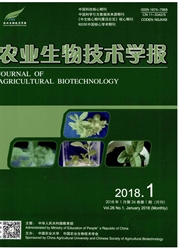

 中文摘要:
中文摘要:
油体蛋白是一类覆盖在油体表面的碱性小分子蛋白。油体蛋白的存在对于维护油体的稳定性非常重要,油体蛋白也是种子作为生物反应器表达重组外源蛋白的重要载体。本研究通过构建花生(Arachishypogaea L.)未成熟种子的全长cDNA文库,测序得到284条编码油体蛋白的EST。根据编码蛋白分子量的大小可将花生油体蛋白基因分为6个亚族:AhOLEO-16.9、AhOLEO-17.7、AhOLEO-18.6、AhOLEO-22、AhOLEO-18.4和AhOLEO-14.3(GenBank登录号分别为:EG372527、EG373122、EG373716、EG372719、EE125019和EE124234),其中AhOLEO-16.9,AhOLEO-17.7和AhOLEO-14.3分别有2个成员,其它家族的各只有1个成员。本研究首次从花生中克隆了分子较大的AhOLEO-22。cDNA芯片和半定量PCR结果表明6个亚族的油体蛋白基因在花生的不同器官和在种子不同发育时期表达模式相似,在根、茎、叶、花中几乎检测不到油体蛋白基因的表达,在种子中表达量高,在果针入土15 d内几乎检测不到油体蛋白基因的表达,随着种子发育成熟油体蛋白基因的表达量逐步提高。本研究为研究花生油体蛋白基因的家族构成和利用花生油体蛋白基因提高花生含油量、生产外源蛋白等提供了有用的信息。
 英文摘要:
英文摘要:
Oleosins are a type of small and basic protein covering the surface of oil body.Oleosin plays an important role in oil body stabilization and is often used as carrier for production of recombinant proteins in plants.The full length cDNA library of cultivated peanut(Arachis hypogaea L.) Luhua14 seeds was constructed and sequenced.From cDNA library we found 284 oleosin ESTs which could be classified into six groups,namely,AhOLEO-16.9,AhOLEO-17.7,AhOLEO-18.6,AhOLEO-22,AhOLEO-18.4 and AhOLEO-14.32 according to molecular weight of their coding proteins(GenBank Accession No: EG372527、EG373122,EG373716,EG372719,EE125019 and EE124234),in which AhOLEO-16.9,AhOLEO-17.7 and AhOLEO-14.3 family contained two members,the others contained one member,respectively,And the higher molecular weight oil oleosin geneAhOLEO-22 was first cloned in peanut.Peanut cDNA microarray and semi-quantitative RT-PCR results showed that the expression patterns of these six sub-family oleosin genes were similar in different organs and in seeds during different developmental stages.The expression of oleosin genes was very high in seed,while the expression of these genes was not detected in stems,leaves,flowers and roots.During seed development,the expression level of oleosin genes was low in DAP15 and gradually increased afterward.This research provides useful information for the study of peanut oleosin gene family as well as using of oleosin to improve peanut oil content and to produce foreign proteins.
 同期刊论文项目
同期刊论文项目
 同项目期刊论文
同项目期刊论文
 期刊信息
期刊信息
